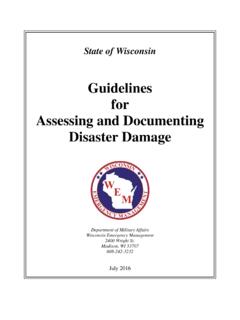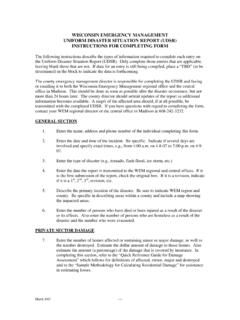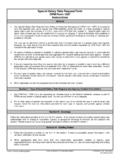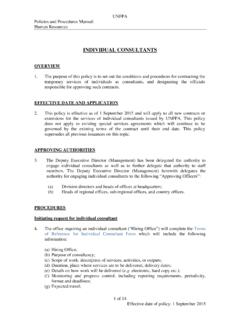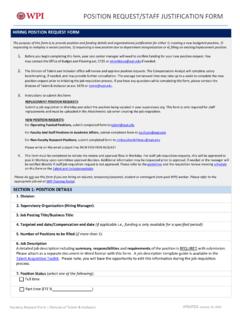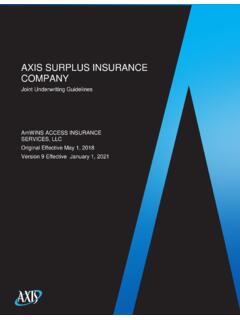Transcription of The Department of Defense Priority Placement Program (PPP ...
1 The Department of Defense Priority Placement Program (PPP). How The PPP. Can Help You! Office of the Deputy Assistant Secretary of Defense (Civilian Personnel Policy). Rights and Benefits of Civilian Employees Affected by Base Closures, Reductions and Consolidations Placement Assistance in The Government All career, career-conditional employees and excepted service employees are given maximum assistance in continuing their careers as employees of the Federal government through assignment to other positions in the Department of Defense (DoD), or other Federal agencies. In addition, in cooperation with the Department of Labor and State Employment Services, assistance will be given to employees in locating positions in private industry. Where appropriate, they will be given the opportunity to undertake retraining programs to qualify them for jobs available in their local labor markets.
2 Employees whose jobs are transferred to other locations may be given the opportunity to transfer with their jobs. The costs of transporting them, their families and households to new locations will be borne by the government. Among the costs that may be paid are moving and transportation of household effects, buying and selling a home, the cost of a house hunting trip to the new locations and temporary quarters subsistence expenses. Employees whose jobs are eliminated will be given Priority rights to other vacant positions in the Defense Department (and other Federal agencies). Employees demoted who are entitled to grade retention will be given Priority rights to other DoD vacant positions in the commuting area at their retained grades. The Department of Defense Priority Placement Program (PPP) provides the principal mechanism for placing affected employees elsewhere in the DoD.
3 Through its Automated Stopper and Referral System (ASARS) the skills of displaced employees are matched with vacant positions at other DoD activities in the authorized area at which the employees are willing to work. If the new job involves a move to another location, the costs of moving the employee and his/her household are borne by the government in accordance with the Joint Travel Regulations, Volume II. If the new job is at a lower grade level, the employee's grade or pay is saved to the maximum extent permitted. Employees may be given Priority consideration for vacancies in other Federal agencies through the Interagency Career Transition Assistance Program (ICTAP). State employment services also provide Placement and retraining assistance for employees desiring jobs in private industry. Following are some specific questions and answers which provide additional detailed information on pertinent aspects of the DoD PPP.
4 1. How Will DoD Assist You In Finding Another DoD Job? The Priority Placement Program provides the primary method by which employees will be afforded maximum opportunity for Placement assistance in other DoD positions and locations. The PPP has been called the most effective outplacement Program in the Federal service. It is an extremely effective Placement assistance system established and maintained to minimize the adverse effects on employees due to such actions as drawdowns, base closures, consolidations, contracting out and classification decisions. Since its inception in 1965, this highly acclaimed Placement system has received the personal support and sanction of every Secretary of Defense . 2. How Effective Is the PPP? To date, over 250,000 employees have been placed through the PPP. More placements could have been made. However, for personal reasons, and despite the fact that employee relocation expenses are paid in accordance with the Joint Travel Regulations, Volume II, some employees are not willing to relocate to other DoD facilities where vacancies exist.
5 Employees who are willing to relocate can greatly enhance their Placement opportunities. 3. How Does the DoD PPP Work? Employees affected by RIF, and those who decline to accompany their function, either by transfer or management reassignment to another commuting area, are registered in a computerized system that is operated in Dayton, Ohio, by the Priority Placement Support Branch (PPSB). As vacancies occur, supporting human resources offices use a computer system to tell PPSB to immediately refer the resumes of employees who match the title, series/occupational codes, and grade/pay band of their vacant position and who have indicated availability for Placement at their DoD location. This referral and matching process can take as little as 24 hours from the time an employee is registered in the PPP. 4. How are Employees Referred for Placement Under the PPP? Employees are referred using a numeric Priority (1 through 3).
6 The Priority assigned is based on the severity of the employee's proposed personnel action. For example, an employee facing reduction-in-force (RIF) separation with no offer of continued employment is assigned a Priority 1, while an employee with a RIF offer of a change to lower grade/pay band one grade/pay band below their current grade/pay band held, is assigned Priority 3. Priority 1 employees must be considered for Placement before Priority 2 and 3 employees. Additionally, the Priority assigned determines which recruitment actions are stopped when a match occurs. 5. What Happens When Resumes Are Received at a DoD Human Resources Office? When the resumes reflect Priorities 1 or 2, all recruiting action STOPS and the job is offered to the highest Priority registrant determined to be well qualified. Priority 3 resumes permit the selection of a current employee of the Component, , Army, Navy or Air Force, but STOPS.
7 New appointments, including reinstatement, and transfers from outside the Component. 6. Is the Offer Mandatory or Does the Manager Have a Choice? Any offer made in accordance with PPP procedures is mandatory, and this mandate is rigidly enforced. Again, the registrant must be well qualified for the job including meeting any reasonable, special qualifications. 7. How Do Managers Feel About the Mandatory Placement of Registrants in Their vacant Positions? We have outstanding support from commanding officers and managers since they understand the reason for PPP placements. Additionally, they know that they are getting a well- qualified employee. Many civilian managers have been placed through the DoD PPP, and they owe the continuity of their careers to this Program . Obviously, they are strong supporters. 8. Do You Have any Statistics on the Success of These Mandatory Placements?
8 In the past few years, we have conducted five follow-up surveys on a fairly extensive basis. Managers have indicated that more than 90 percent of all PPP placements resulted in their receiving an employee that was equal to or better than candidates selected through the merit promotion process. 9. With That Type of Success, the Registration Requirements Must be Rigid. Are They? In order to be registered, the employee must be well qualified, that is, be able to satisfactorily perform the duties of the position with orientation only, and the registrant's performance and conduct must not be in question. The well qualified determination is initially made by the registering personnel office and confirmed between the registering and gaining activities before offers are confirmed. 10. How Many Offers Does the Registrant Have from Which to Choose? One. The employee is told at the time of registration that only one valid offer is authorized, so they are careful to register for locations and skills that are acceptable.
9 They must accept or decline offers from CONUS activities within 2 business days of having received the offer. Registrants outside of CONUS must accept or decline an offer within 3 business days of receipt. 11. Can the Employee Select Any DoD Installation in the World for Registration Purposes? No. The employee's supporting human resources office determines the appropriate geographic area necessary to afford a reasonable opportunity for Placement . The employee may then designate activities in that area which are acceptable. The geographic areas for which registration is made are determined on such criteria as the skill(s) for which the employee is sufficiently well qualified and how well represented those skills are in that geographic area. For example, skills that are common at many DoD locations could dictate a narrower referral area than unusual skills that are not widely represented within the DoD.
10 12. With So Many Installations in Tight Budgetary Situations and/or Having to Reduce the Civilian Workforce, Is it Realistic for an Employee at a Base to be Closed to Expect a Job Offer Through the DoD PPP? DoD has taken measures to lessen the impact of DoD downsizing on employees who either are losing their job or being displaced. Some of the measures include offering retirement and resignation incentives to create vacancies and offering outplacement subsidies to non-DoD. agencies to hire surplus DoD employees, thus giving employees more time to be placed prior to separation. Again, employees need to be flexible in their decisions when registering in the Priority Placement Program and carefully consider their options to increase their Placement opportunities. The supporting human resources office will provide trained counselors to assist in this effort. 13. Is the DoD PPP Cost Effective?

